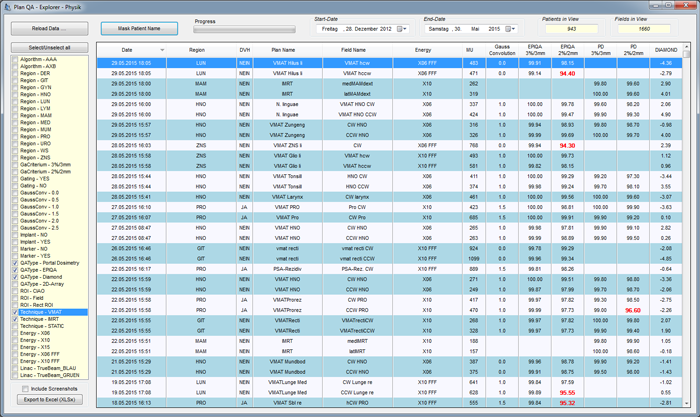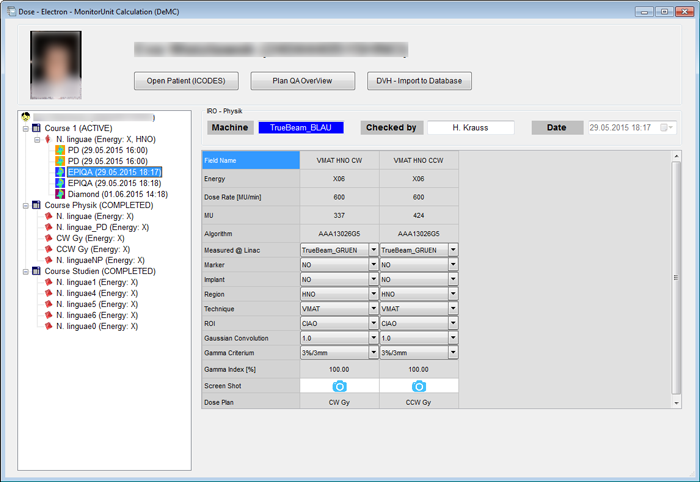Portal Dosimetry and Diamond Plan QA Results: 2013 - May 2015
We want to present some Plan QA results for VMAT and IMRT fields verified since the first TrueBeam went clinical. The list contains measurements performed with the EPID as well as the calculation results of PTW Diamond, but not the verification measurements of the 2D-Array.
We document Plan QA results in iCheckNet:
For EPIQA and Varian Portal Dosimetry (abbreviated with VPD or PD), the Gamma Agreement Index (GAI) in percent is calculated for 3%/3mm and 2%/2mm. The ideal GAI is 100%. A screenshot of each analysis is also saved in iCheckNet.
FFF plans can currently only be evaluated with EPIQA and Diamond. We work with the older IDU20 detector, and Eclipse does not support Portal Dose Image Prediction for the IDU20, only for the DMI. LF-IMRT plans can only be evaluated with VPD and Diamond, because EPIQA 4.0.8 does not support multiple carriage groups retained in a single field.
PTW Diamond calculates dose at a user-given calculation point, the dose deviation compared to Eclipse is given in [%]. See an description of our workflow before Diamond 6.0. With the new release, it is not necessary anymore to modify Body structures.
The goal is to reach in Portal Dosimetry at least a GAI of 97% for 3%/3mm, or a Diamond deviation below 5%. If this is not reached, the field is usually measured with the 2D-Array.
This is a typical patient view:
In the typical VMAT situation with flattened beams, the plan icon in the navigator on the left (plan name is "N.linguae") has five icons attached: two for EPIQA, two for VPD, and one for Diamond. The camera icons are hyperlinks to screenhots.
For each plan, a two to three letter code describes in a very simplistic way the body region where the VMAT or IMRT treatment was applied. It is formed from the description in German, and is not always identical with the region of the primary tumor. A metastasis of a prostate carcinoma could be in the spine region, and if this metastasis is treated, it gets the WS ("Wirbelsäule") code, not the PRO code:
- PRO = prostate
- HNO = head and neck
- GIT = gastrointestinal region (rectum, ani, liver, ...)
- MAM = breast
- LUN = lung
- ZNS = cervical region
- WS = spine
- GYN = gynaecologic region
- MED = mediastinum
- URO = urologic region (bladder etc.)
- LYM = lymphoma (see below)
- MUM = multiple myeloma (see below)
- DER = skin
Exceptions of this rule are LYM and MUM. Lymphomas can appear anywhere in the body, such as in the head and neck, or in the gynaecologic region. We did not want to give the lymphoma plan either code (HNO or GYN), because the purpose of the region codes is more to provide to the physicist a way of filtering "typical" plans for a certain region. However, there is no such thing as a "typical lymphoma plan", so we kept the LYM code for all lymphoma plans in the body. The same is true for MUM.
The long list contains the results for 943 patients (treated between January 2013 and May 2015), 1660 fields, and has links to over 5000 screenshots. It was generated using iCheck's Export to Excel function.
Historical Notes
After June 2014, VPD results improved considerably due to the switch to Varian's PDPC (Portal Dose Pre-Configuration) package for TrueBeam 2.0 and IDU20.
Late 2014, we started testing of Diamond 6.0 Beta. In the meantime, PTW has officially released Diamond 6.0. The release has made it possible to correct for tissue heterogeneities. Now it is much easier to achieve calculation deviations below 5% for VMAT.

